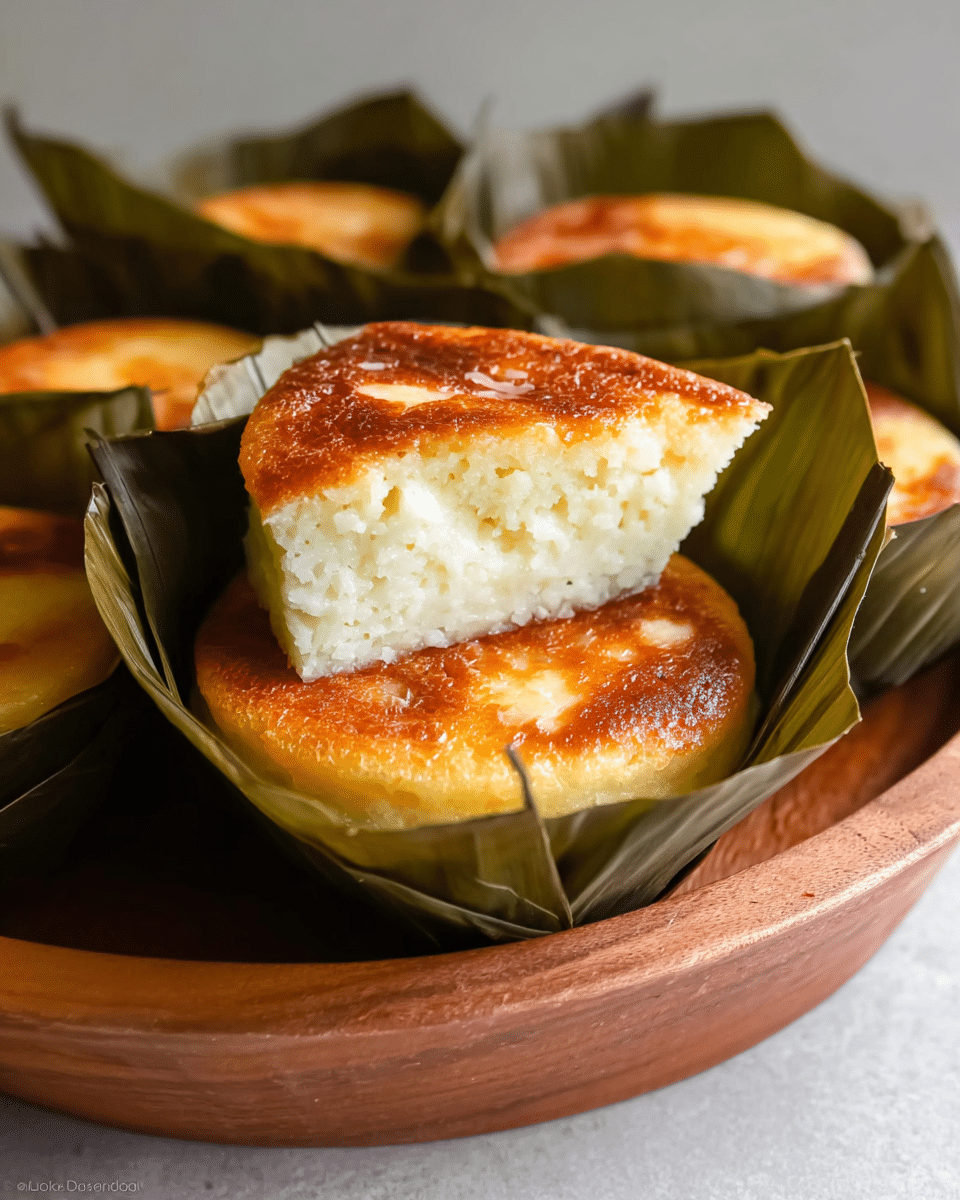Bibingka is a traditional Filipino rice cake that’s both soft and fluffy, with a lovely coconut flavor. Baked in banana leaves, this version of bibingka uses a blend of rice flour and all-purpose flour for a light and airy texture. The rich coconut milk adds a delicious depth of flavor, and the slight sweetness of the cake is complemented by the distinct aroma from the banana leaves. A perfect treat for the holidays or any special occasion!
Full Recipe:
Ingredients
-
Banana Leaves (to line molds or tins)
-
For the Cake:
-
180g rice flour
-
45g all-purpose flour
-
24g baking powder (about 2 tbsp)
-
¼ tsp kosher salt
-
4 large eggs (room temperature)
-
300g granulated sugar
-
13.5 oz can full-fat coconut milk (well-shaken)
-
57g unsalted butter (melted)
-
-
Topping:
-
Cream cheese (thinly sliced, as needed for topping)
-
Directions
-
Prepare Banana Leaves: Thaw the frozen banana leaves at room temperature or under cool running water. Rinse and pat them dry. Remove the thick rib from the center to make the leaves more pliable. Warm the leaves over an open flame until shiny and deep green, being careful not to burn them.
-
Prepare Muffin Tin: Grease a 6-cup muffin tin and line each cavity with banana leaves, brushing them with melted butter.
-
Mix Dry Ingredients: Sift together rice flour, all-purpose flour, baking powder, and salt in a medium bowl. Set aside.
-
Make Batter: In a large bowl, whisk the eggs and granulated sugar until smooth. Add the coconut milk and melted butter, mixing until combined. Gradually fold in the dry ingredients and mix until smooth and well combined.
-
Assemble and Bake: Pour ½ cup of the batter into each prepared muffin tin. Bake in a preheated 375°F (190°C) oven for 20 minutes. Add slices of cream cheese on top of each bibingka and continue to bake for another 10-15 minutes, or until set and a toothpick inserted comes out clean.
-
Serve: Allow the bibingka to cool slightly, then remove from the muffin tin. Best served warm.
Nutrients (per serving)
-
Calories: 246 kcal
-
Carbohydrates: 35g
-
Protein: 3g
-
Fat: 11g
-
Saturated Fat: 8g
-
Cholesterol: 62mg
-
Sodium: 248mg
-
Potassium: 95mg
-
Fiber: 0.4g
-
Sugar: 21g
This coconut rice cake is soft, slightly sweet, and filled with aromatic flavors—perfect for any Filipino feast or as a special treat!
A Glimpse into Filipino Culinary Traditions
The Philippines has a rich culinary heritage, shaped by various indigenous, Asian, and Western influences. Filipino food reflects the country’s history, with each dish telling a story of culture, community, and celebration. Bibingka holds a special place in the hearts of many Filipinos. Traditionally, this rice cake was baked in clay ovens, known as “bibingkahan,” using live charcoal for heat. The cake would often be served with toppings like salted duck eggs, grated coconut, or cheese, making it a versatile treat.
In modern times, bibingka is typically baked in ovens, but the essence of the dish remains the same. Its soft, spongy texture and sweet, coconut flavor bring comfort to anyone who enjoys it. The use of banana leaves adds not only a unique aroma but also an environmentally friendly touch to the preparation process. It’s no wonder that bibingka is often present at Filipino holidays, such as Christmas, where families come together to share this special treat.
The Significance of Banana Leaves
One of the most distinct features of bibingka is the way it is baked – wrapped in banana leaves. These leaves impart a subtle, earthy aroma that enhances the flavor of the rice cake. Banana leaves are abundant in the Philippines and have long been used in Filipino cooking. They are not just for presentation but also serve as an essential component of the baking process. The natural oils in the leaves keep the cake moist while baking, and the leaves themselves act as a non-stick surface, eliminating the need for additional greasing or pans.
The banana leaves used for bibingka must be prepared carefully. Thawing frozen banana leaves or warming them over an open flame makes them pliable, ensuring they will conform to the shape of the baking tin or mold. Once ready, they line the baking tins, adding a rustic touch to the final presentation.
The Key Ingredients That Make Bibingka So Special
Bibingka’s flavor is defined by its unique combination of ingredients. The rice flour forms the base of the cake, giving it its traditional texture – soft, slightly chewy, and fluffy. The addition of all-purpose flour creates a lightness and a slightly crisp texture on the outside, making each bite of bibingka a delightful contrast of tenderness and bite.
Coconut milk is another integral ingredient in bibingka, lending a rich and creamy flavor that elevates the cake’s sweetness. The natural sweetness of coconut milk melds perfectly with the lightness of the cake, offering a comforting, almost indulgent experience without being overly rich. For an added touch, the cake is topped with thin slices of cream cheese, adding a salty contrast to the sweetness of the cake, a modern twist on the traditional recipe.
Eggs, sugar, and butter bring moisture and sweetness to the bibingka batter. The eggs help bind the ingredients together while providing structure to the cake. The granulated sugar ensures a touch of sweetness without overpowering the other flavors. Finally, the melted butter contributes to the moistness and richness of the bibingka, helping it to achieve the perfect texture.
Baking and Assembly: Bringing It All Together
The process of making bibingka begins with preparing the banana leaves. After thawing and softening the leaves, they are placed inside muffin tins or traditional molds, brushed with melted butter to prevent sticking. Next, the dry ingredients—rice flour, all-purpose flour, baking powder, and salt—are sifted together, ensuring an even mixture. This step helps to incorporate air into the dry ingredients, which contributes to the light, fluffy texture of the cake.
The wet ingredients are then prepared by whisking eggs and sugar until smooth. The coconut milk and melted butter are added to this mixture, creating a smooth batter. Gradually, the dry ingredients are folded into the wet mixture, ensuring that the batter is smooth and well-combined. This step is crucial to achieving the light texture that defines bibingka.
Once the batter is prepared, it is poured into the banana leaf-lined molds, filling each one about halfway. The bibingka is baked at a moderate temperature, allowing it to cook through evenly. After about 20 minutes, slices of cream cheese are placed on top of the cakes, where they melt and slightly brown, creating an irresistible topping. The cakes are then baked for an additional 10-15 minutes until they are set and a toothpick inserted comes out clean.
Serving and Enjoying Bibingka
Bibingka is best served warm, fresh from the oven. Its soft, slightly sweet texture and subtle coconut flavor make it a perfect treat for any occasion. The banana leaves, once peeled away, reveal the golden brown rice cakes with a slight sheen of melted butter on top, inviting you to take a bite.
In the Philippines, bibingka is often served as part of a larger feast, particularly during Christmas. It can be paired with other Filipino delicacies, such as puto bumbong, another rice-based cake, or enjoyed as a snack with a cup of hot chocolate or coffee. Whether as part of a festive gathering or as a special indulgence for yourself, bibingka never fails to bring a sense of comfort and warmth.
The Cultural and Social Importance of Bibingka
Bibingka is more than just a dessert; it is a symbol of Filipino culture and hospitality. In many Filipino households, the act of preparing bibingka is a communal experience. Families gather together to bake, share, and enjoy this sweet treat. For many, it brings back memories of childhood holidays spent with loved ones, filling the air with the comforting aroma of baking rice cakes.
Moreover, bibingka plays a significant role in Filipino celebrations. During Christmas, it is often sold by street vendors outside churches, particularly during the “Simbang Gabi,” the early morning Masses leading up to Christmas Eve. The tradition of eating bibingka after church services is a beloved part of the holiday season, and the cake itself has become synonymous with Filipino Christmas celebrations. It is a food that connects people to their heritage, bringing both old and young together to savor the flavors of their past.
Conclusion
Bibingka is a delightful Filipino treat that blends the rich flavors of coconut, the lightness of rice flour, and the aromatic essence of banana leaves. Whether you’re enjoying it during the holidays or as a special snack for any occasion, this dish is sure to bring joy to your taste buds and your heart. With its soft, fluffy texture and slightly sweet flavor, bibingka is a true testament to the warmth and hospitality of Filipino cuisine. Whether you’re new to Filipino food or a lifelong fan, giving bibingka a try is a perfect way to experience the flavors and culture of the Philippines.

